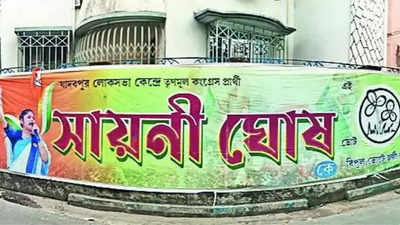- News
- City News
- kolkata News
- End of election graffiti? 70ft wrap-around banners new flex of poll season in Kolkata
Trending
End of election graffiti? 70ft wrap-around banners new flex of poll season in Kolkata
In Kolkata, the traditional election graffiti on walls is being replaced by 70ft wrap-around flex banners, a new trend in the current election season, making political advertising more prominent.

A flex banner adorning the boundary wall of a building in Garia
In Jadavpur Lok Sabha constituency, a mega flex banner measuring 70ftx8ft seeking votes for Trinamool candidate Sayoni Ghosh covers the boundary wall of a factory on NSC Bose Road near Naktala.Another 30ft flex hides the boundary wall of a private building in Garia. While the giant flex banners are more a south Kolkata phenomenon, smaller flex boards now dot the entire city. In Kestopur on VIP Road, the boundary wall of a banquet hall sports flex posters of all three prominent Dum Dum candidates - Trinamool's Sougata Roy, BJP's Silbhadra Datta and CPM's Sujan Chakraborty.
In past elections, wall pai-nters were engaged to draw party symbols, portraits of candidates and write messages on walls urging citizens to vote. Though the graffiti was erased after the elections with a coat of limewash, it used to leave the walls scarred.
Soumya Mukherjee of SM Enterprise that prints flex posters and banners says demand has increased manifold this election. "With the election stretching for over two months, demand has been very high. It makes sense for parties to use flexes. It is cheaper than hiring a wall artist and saves time," he said.
Poll managers say use of flexes for political advertising is much cheaper - it costs Rs 8 to Rs 20 per sq ft depending on the thickness of the sheet used - is less time-consuming, easier to put up and dismantle. It also leaves house owners happy since they don't have to grapple with def-acement of their walls.
"During the late 80s, we would put stone chips on the outer walls of our building to deter political parties from covering them with graffiti," said Bhowanipore resident Soumitra Das.
Greens worried over flex disposal
Septuagenarian Swapan Chatterjee, who resides in a multi-storied building opposite the Naktala factory, too, welcomed the development. "This can end the defacement of walls during polls," he said. Subhomoy Bandhyopadhyay, a city businessman, said he found the digitally designed flex posters "smart and trendy".
A few citizens, however, rue the end of an era. Rajib Das, a Bansdroni resident said wall-writing had its own charm that would soon disappear like artwork posters of movies. "There was so much variety earlier, different painting styles, use of cartoons, intelligent use of quotes, slogans and colours. All that will soon be history," he said.
Md Anwar of Alimuddin Street, who used to be in huge demand for his 'walling' skills during elections till a decade ago, said, "The golden era of poll wallings is over. Demand for wall writing has reduced dramatically. Part of it is also because the next generation is not interested in the labourious work."
Environmentalists, however, are concerned about the increase in use of flex and their disposal after the polls. West Bengal Pollution Control Board (WBPCB) has asked all political parties to responsibly dispose of or recycle banners used during campaigns. The pollution watchdog has said that all PVC flex, banners, and hoarding items need to be routed through 15 registered plastic waste recyclers so that they can be turned into granules for use in pipes and tubes.
"We have to prevent these materials from landing at landfill sites like Dhapa," siad PCB chairman Kalyan Rudra.
(Inputs from Mayukh Sengupta)
End of Article
FOLLOW US ON SOCIAL MEDIA










